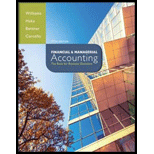
Financial & Managerial Accounting
17th Edition
ISBN: 9780078025778
Author: Jan Williams, Susan Haka, Mark S Bettner, Joseph V Carcello
Publisher: McGraw-Hill Education
expand_more
expand_more
format_list_bulleted
Question
Chapter 14, Problem 9E
a.
To determine
Explain the conclusions that can be drawn regarding the change in the size of Incorporation HD during the five-year period.
b.
To determine
Comment on the five-year trend in net earnings as a percentage of sales and explain the trend for the viewpoint of a potential investor of the company.
c.
To determine
Explain whether the company’s liquidity improved or diminished over the five-year period.
Expert Solution & Answer
Want to see the full answer?
Check out a sample textbook solution
Students have asked these similar questions
Thompson, Inc. had accounts receivable of $580,000 and an allowance for doubtful accounts of $23,400 just before writing off as worthless an account receivable from Sullivan Company of $2,750. The net realizable value of the accounts receivable before and after the write-off was: A. $556,600 before and $556,600 after. B. $603,400 before and $600,650 after. C. $556,600 before and $553,850 after. D. $580,000 before and $577,250 after.
I am looking for help with this general accounting question using proper accounting standards.
Frontier Manufacturing recently purchased 182,000 units of raw material for $710,000. Four units of raw materials are budgeted for use in each finished good manufactured, with the raw material standard set at $34.00 for each completed product. Frontier manufactured 38,750 finished units during the period just ended and used 169,425 units of raw material. If management is concerned about the timely reporting of variances in an effort to improve cost control and bottom-line performance, what would the materials purchase price variance be? HELP
Chapter 14 Solutions
Financial & Managerial Accounting
Ch. 14 - Prob. 1STQCh. 14 - Prob. 2STQCh. 14 - Prob. 3STQCh. 14 - Prob. 4STQCh. 14 - Prob. 5STQCh. 14 - Prob. 6STQCh. 14 - Prob. 7STQCh. 14 - Prob. 1DQCh. 14 - Prob. 2DQCh. 14 - 3. Distinguish between trend percentages and...
Ch. 14 - Prob. 4DQCh. 14 - Prob. 5DQCh. 14 - Prob. 6DQCh. 14 - 7. What is the characteristic common to all...Ch. 14 - Prob. 8DQCh. 14 - Prob. 9DQCh. 14 - Prob. 10DQCh. 14 - Prob. 11DQCh. 14 - Prob. 12DQCh. 14 - Prob. 13DQCh. 14 - Prob. 14DQCh. 14 - Prob. 15DQCh. 14 - BRIEF EXERCISE 14.1
Dollar and Percentage...Ch. 14 - BRIEF EXERCISE 14.2
Trend Percentages
Star, Inc.,...Ch. 14 - Prob. 3BECh. 14 - BRIEF EXERCISE 14.4
Working Capital and Current...Ch. 14 - BRIEF EXERCISE 14.5
Current and Quick Ratio
Foster...Ch. 14 - BRIEF EXERCISE 14.6
Debt Ratio
Jarman Company had...Ch. 14 - Prob. 7BECh. 14 - BRIEF EXERCISE 14.8
Earnings per Share
Multi-Star,...Ch. 14 - Prob. 9BECh. 14 - BRIEF EXERCISE 14.10
Return on Equity
Prince...Ch. 14 - Prob. 1ECh. 14 - LO14-1
EXERCISE 14.2
Trend Percentages
Compute...Ch. 14 - LO14-1
EXERCISE 14.3
Common Size Income...Ch. 14 - EXERCISE 14.4
Measures of Liquidity
Roy’s Toys is...Ch. 14 - Prob. 5ECh. 14 - Prob. 6ECh. 14 - Prob. 7ECh. 14 - Prob. 9ECh. 14 - Prob. 10ECh. 14 - Prob. 11ECh. 14 - Prob. 12ECh. 14 - Prob. 13ECh. 14 - Prob. 14ECh. 14 - Prob. 15ECh. 14 - Prob. 1APCh. 14 - Prob. 2APCh. 14 - Prob. 3APCh. 14 - LO14-3, LO14-4, LO14-7
PROBLEM 14.4A
Liquidity of...Ch. 14 - Prob. 5APCh. 14 - Prob. 6APCh. 14 - Prob. 7APCh. 14 - Prob. 8APCh. 14 - Prob. 9APCh. 14 - Prob. 1BPCh. 14 - Prob. 2BPCh. 14 - Prob. 3BPCh. 14 - Prob. 4BPCh. 14 - PROBLEM 14.5B
Balance Sheet Measures of Liquidity...Ch. 14 - Prob. 6BPCh. 14 - Prob. 7BPCh. 14 - Prob. 8BPCh. 14 - Prob. 9BPCh. 14 - Prob. 1CTCCh. 14 - Prob. 2CTCCh. 14 - Prob. 3CTCCh. 14 - Prob. 5CTCCh. 14 - Prob. 4CP
Knowledge Booster
Similar questions
- Please explain the solution to this general accounting problem with accurate principles.arrow_forwardNeed answer general accounting questionarrow_forwardHalle Company disposed of an asset at the end of the sixth year of its estimated life for $12,500 cash. The asset's life was originally estimated to be 9 years. The original cost was $63,000 with an estimated residual value of $6,300. The asset was being depreciated using the straight-line method. What was the gain or loss on the disposal?arrow_forward
arrow_back_ios
SEE MORE QUESTIONS
arrow_forward_ios
Recommended textbooks for you

 AccountingAccountingISBN:9781337272094Author:WARREN, Carl S., Reeve, James M., Duchac, Jonathan E.Publisher:Cengage Learning,
AccountingAccountingISBN:9781337272094Author:WARREN, Carl S., Reeve, James M., Duchac, Jonathan E.Publisher:Cengage Learning, Accounting Information SystemsAccountingISBN:9781337619202Author:Hall, James A.Publisher:Cengage Learning,
Accounting Information SystemsAccountingISBN:9781337619202Author:Hall, James A.Publisher:Cengage Learning, Horngren's Cost Accounting: A Managerial Emphasis...AccountingISBN:9780134475585Author:Srikant M. Datar, Madhav V. RajanPublisher:PEARSON
Horngren's Cost Accounting: A Managerial Emphasis...AccountingISBN:9780134475585Author:Srikant M. Datar, Madhav V. RajanPublisher:PEARSON Intermediate AccountingAccountingISBN:9781259722660Author:J. David Spiceland, Mark W. Nelson, Wayne M ThomasPublisher:McGraw-Hill Education
Intermediate AccountingAccountingISBN:9781259722660Author:J. David Spiceland, Mark W. Nelson, Wayne M ThomasPublisher:McGraw-Hill Education Financial and Managerial AccountingAccountingISBN:9781259726705Author:John J Wild, Ken W. Shaw, Barbara Chiappetta Fundamental Accounting PrinciplesPublisher:McGraw-Hill Education
Financial and Managerial AccountingAccountingISBN:9781259726705Author:John J Wild, Ken W. Shaw, Barbara Chiappetta Fundamental Accounting PrinciplesPublisher:McGraw-Hill Education


Accounting
Accounting
ISBN:9781337272094
Author:WARREN, Carl S., Reeve, James M., Duchac, Jonathan E.
Publisher:Cengage Learning,

Accounting Information Systems
Accounting
ISBN:9781337619202
Author:Hall, James A.
Publisher:Cengage Learning,

Horngren's Cost Accounting: A Managerial Emphasis...
Accounting
ISBN:9780134475585
Author:Srikant M. Datar, Madhav V. Rajan
Publisher:PEARSON

Intermediate Accounting
Accounting
ISBN:9781259722660
Author:J. David Spiceland, Mark W. Nelson, Wayne M Thomas
Publisher:McGraw-Hill Education

Financial and Managerial Accounting
Accounting
ISBN:9781259726705
Author:John J Wild, Ken W. Shaw, Barbara Chiappetta Fundamental Accounting Principles
Publisher:McGraw-Hill Education